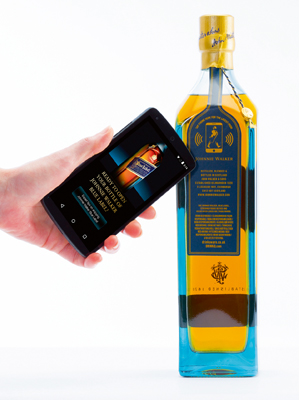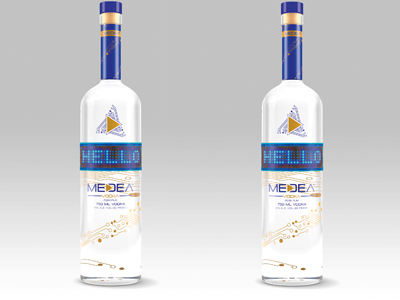Medea Vodka bottles saying ‘hello’
While not using digital printing technology, an interesting sector of packaging is adding digital capability to the pack, through the adoption of electronics. This could be an RFID tag, or increasingly, printed electronics as a circuitry or a display, while there are developments to print battery power sources or photovoltaic materials. As smart functions are growing in homes, the idea of interacting directly with a pack is becoming mainstream. By Sean Smyth.
Packaging has evolved into a world market worth some £450 billion in 2016, according to Smithers Pira. Now new developments are broadening the functions of packaging, adding smart functionality. Material science developments are improving physical properties of packaging, increasing the strength and barrier performance at lighter weight to reduce the cost and environmental impact. Speciality chemicals may be added to surfaces, to extend shelf life by absorbing moisture or CO2, or blocking UV light.
Electronic functionality
The other strand of smart packaging is to add electronic capability to the pack. One high profile example of this is Medea Vodka. This is a premium vodka and bottles include an LED display. There is also an aerial and circuitry that can receive text messages, a popular feature for hipsters in trendy bars (I am told). It allows customers to interact with the product in a totally new way, creating interest in social media and ‘buzz’ around the brand, helping Medea in the very crowded sector of boutique premium spirits. This is a complex arrangement with circuitry and separate power source. Other developments are incorporating everything into a single integrated circuit, and these are being printed.
RFID (radio frequency identification) tags have been around for many years but have not taken off in high volume, fast moving consumer goods because of the cost. Other tags now being examined include low energy Bluetooth (BLE) and near field communication (NFC). These identify the item to a reader, very useful in logistics and tracking, and to add functionality to a pack. Diageo produced a bottle of Johnnie Walker Blue Label whisky with an NFC tag that communicates with a smartphone App to verify that the bottle is genuine. A useful function when it sells for £200 per bottle (or over £5000 in a posh travelling case from Harrods).

Johnnie Walker whisky bottle with smartphone validation
The innovation was created by Thinfilm, a Norwegian developer, in collaboration with Diageo, using near field communication (NFC) capabilities. The tags are permanently encoded at manufacture and cannot be copied or electrically modified. Davor Sutija, Thinfilm’s CEO commented, ‘As mobility becomes ubiquitous, consumers want and expect brands to follow suit and deliver custom mobile experiences. But today’s conventional NFC mobile marketing solutions are not technologically advanced enough to create immersive or customisable consumer experiences.’
Thinfilm is enabling smart bottles that carry digital information beyond the security functions. The sensors mean Diageo can send information to customers who scan the bottle with their smartphones and change that information, thanks to the sensors being ‘always connected’. For instance, Diageo might upload a promotional offer while the bottle is on sale, then change that information to cocktail recipes when the sensor shows the bottle has been opened. NFC OpenSense tags are thin, flexible labels that can detect both a product’s factory sealed and opened states, and wirelessly communicate contextual content to consumers via an NFC-enabled smartphone. Each tag is unique and enables item-level communication to a market of one.
Many functional packaging niches are showing promise – tracking the ambient conditions of a perishable item is valuable, maybe monitoring the temperature of storage for a vaccine that will be used in equatorial regions that may be destroyed by prolonged exposure to high temperatures. Several pharmaceutical carton suppliers have included a screen in the box, showing how to use the drug or medical device. For example Rondo Pak has produced a carton incorporating a screen that can play a high definition video, to attract attention on shelf or to provide information after purchase. The multi-media cartons are designed for product launches, patient education kits, physician training kits, clinical trials and sales demonstrations. Many examples have been described as market testing concepts, but electronic packaging has not yet hit the mainstream. There are signs that this is changing. One key enabler is lower cost tags and components, and directly printing them will significantly reduce costs.
More shelf appeal
Printed electronics is rapidly progressing, using new conductive inks to create good performance, reliable printed circuitry using traditional high volume print technology that is widely used in packaging. Other teams are looking at inkjet. New inks and coatings are being developed that will enable smart technologies, with developers formulating printable inks with good electrical conductivity (or resistance) properties. Much work is looking at printing silver or copper tracks; the trick is to get rid of the non-electrical components when printed but make sure the track is consistent and contiguous with no breaks. One that came successfully to market was the electro-luminescent inks on Bombay Sapphire Gin cartons.
There is also work on printing OLED (organic light emitting diode) materials to create low cost thin and flexible displays. Printing is a key part of the latest manufacturing methods for monitors, TVs, tablets and mobile phones among other devices. The leading suppliers of displays for TVs and smart phones in Korea are exploring new markets for their products. These are mostly glass and will be panels on domestic appliances (washing machine, radio, microwave, etc) or a dashboard display in a car or truck.
Part of the production method involves printing and new lightweight flexible materials will open new applications. Displays on packaging and labels represent a huge potential market. Proponents believe that incorporating a display onto a pack will increase the shelf appeal of a pack, differentiating it and increasing the appeal to consumers, important in the luxury market. The technology can also be used to change the pack design, useful to update pricing or to provide a message tailored to a potential customer who can be detected through low energy Bluetooth or NFC from their mobile phone. The pack could provide additional information, on its status and this is being explored in some pharmaceutical applications.
Smart fridge
New smart technologies are under development – the Consumer Electronics Show held each year in Las Vegas gives clues to the future. Smart appliances are coming to the market. These are e-enabled, including washing machines that track the use of detergent and fabric conditioner and can link to auto replenishment systems to automatically re-order supplies before it runs out. This could be linked to an electronic tag on the consumables to make sure the correct amount is used for a particular wash cycle. Perhaps a more useful function might be to link a pack to a microwave oven, so the right cooking cycle is used to ensure that food is properly cooked.
Samsung showed its Family Hub Fridge, an upmarket refrigerator with a large touch screen that can connect to the internet. There are three cameras in the door that display the contents with an App that tracks when an item is put into the fridge, when it reaches its best-before date, or when it runs out and can place an order with an online retailer. Samsung is looking to develop the system, adding reading capability to interrogate a pack which contains more information about a product. The potential is not just for the fridge to reorder groceries and warn about out of date products, it would also know the nutritional information and could warn about potential issues for an owner who has a food allergy or intolerance.
As with much new technology, many of these developments fall into the ‘technology looking for a market category’ that have been singularly unsuccessful because they don’t solve existing pain points or provide sufficient added value to make it worthwhile implementing. Features that end users value will take off and predicting how people will react is always challenging, but the requirement for convenience, safety and sustainability are real. Identifying packs and simplifying ordering processes are important, as is aiding recycling at the end of life. There will also be attention-grabbing examples, for example ClickStick deodorant that tracks your use of deodorant. There will be more.






